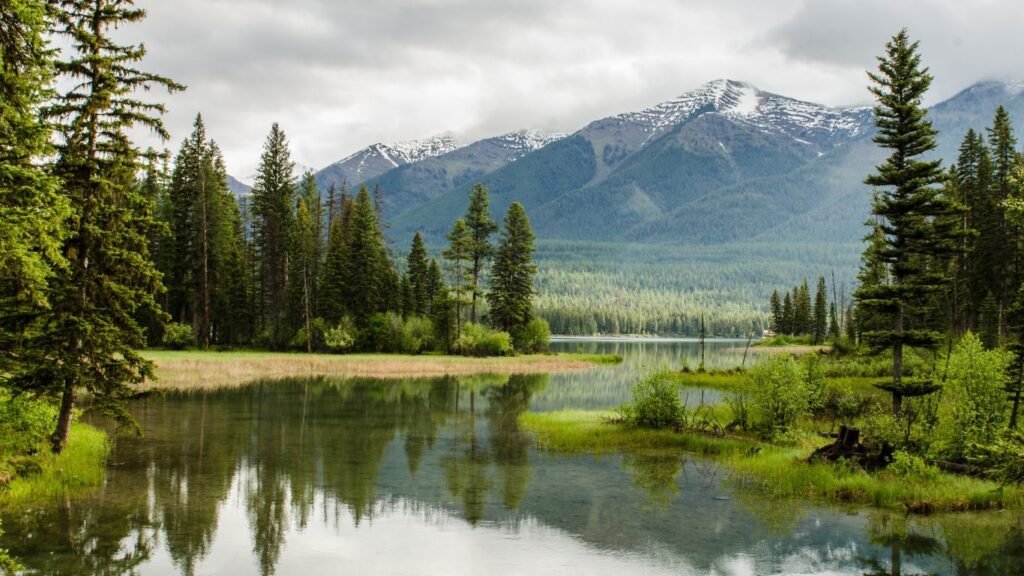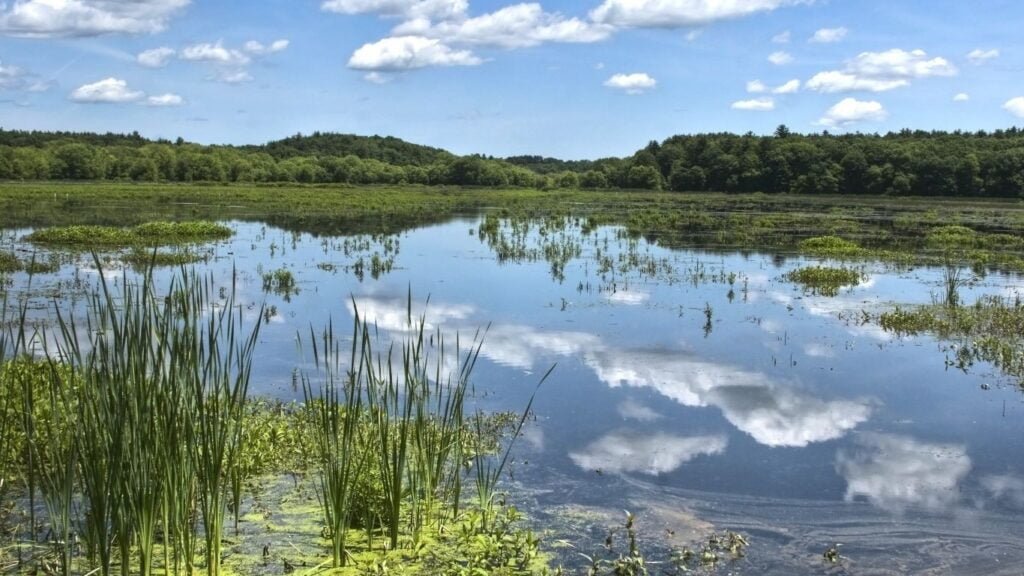This blog contains information about Wetlands. In the start, it discuss the definition and explanation of wetlands. Then it elaborates the Types of Wetlands with detail. It also explain the Benefits of Wetlands. Then it discusses the Way for Conservation of Wetlands. In the end, it contains detail about RAMSAR Convention and RAMSAR sites in Pakistan. This blog contains Types, Benefits, Conservation and RAMSAR convention on Wetlands.
Definition of Wetlands:
A wetland is the soil area that is covered with water throughout the year or during a certain period of the year. The water present on the wetlands, can be near the surface or soil and it can be in depth because of large amount of water present in that area.
Wetlands can be any natural or artificial location that is covered with water. These water resources are very important in our environment. Wetland conservation provides us so much benefits in our daily life and on ecosystem level.
Natural Wetlands are more effective and important than artificial wetlands. Wetlands can be in the form of collected rain water because of any depression on land. Or it can be any part of a river that is separated in the form of a huge puddle.
Artificial wetlands are water reservoirs or resources, that are created by humans. These wetlands are mimics of natural wetlands and we try to get equivalent advantage of these wetlands as the Natural ones.
Wetlands provide us freshwater and a wide range of freshwater plants and animals species. These freshwater plants help us to treat the contaminated water naturally through treatment. The water found in the wetlands treats itself on its own and so as can be utilized by humans and animals for cooking and drinking purposes.
This blog contain detailed description of benefits, types, and Conservation of wetlands.
Types of Wetlands:
Following are the four types of Wetlands found on Earth:
1. Marshes:
These are the wetlands that are frequently and continually filled with water in huge amounts. This water remains here throughout the year. Marshes are mostly filled with surface water i.e. rainwater, runoffs etc. These wetlands act as natural Rainwater harvesting systems. Some of its water can be used to recharge groundwater too. These supports submerged vegetation and freshwater species of animals. It also play a great role in storing and conserving flood water. Its natural vegetation remove the harmful pollutants from the water and hold them on to the surface to make water clean and healthy.
2. Swamps:
Swamps are another type of wetlands. These are distinguished by the presence of woody plants in them. They are the home for thick and tall water tolerant trees. Many rare and beautiful plants and animals use swamps as their permanent habitat and get shelter in it. Freshwater species are present in bulk in swamps. Its main role is nutrient removal from water to avoid Eutrophication. Swamps are also a source of high quality timber that can be harvested sustainably and used for building purposes. These wetlands are beautiful and contain many abilities to restore the nature in natural way.
3. Bogs:
These are the third type of wetlands that are distinctive in nature. Bogs contains spongy peat reserves in their locations. They are filled and utilized by precipitation water instead or runoff and groundwater. It also contains acidic environment of water. Bogs play a great role in preventing or stopping downstream flooding by absorbing large concentration of precipitation. They are home of threatened and endangered species of plants and animals. We get peat from bogs in great amounts, that can be used to make fuel. Peat deposits also stores a lot of carbon in it so it contributes in removing CO2 from the atmosphere.
4. Fens:
Fens are resources that get water from the sources other than precipitation such as runoff, groundwater, etc. These are less acidic in nature as compared to Bogs. But they help a diverse community of plants and animals to live and get food from it. With passing time, peat produce a barrier between the fens and groundwater. This separation leaves it with less nutrients and transforms it into a Bog. Fens provide watershed benefits, reduce flood risks, improve the quality of water and many other environmental benefits are associated with Fens but these can be destroyed by mining practices, fuels and fertilizers.
These are the basic types of Wetlands. This blog contains Types, Benefits, Conservation and RAMSAR Convention on Wetlands.

Benefits of Wetlands:
Following are some of the benefits of Wetlands:
i. Provide Habitats:
Wetlands are important because they provide habitats to thousands of species of rare and endangered plants and animals to live and survive. It includes freshwater species, fishes, frogs, crocodiles, shrimps, mosses, shrubs, timber trees and many more environmentally and economically important species.
ii. Treat Wastewater Naturally:
Wetlands treat the toxic contaminants and pollutants found in the water so all types of water enters into the wetlands. These types include agricultural runoff, industrial wastewater, groundwater and surface water. With passing time, the aquatic species treat the polluted water and change it into fresh, drinkable water that humans and other living organisms can also utilize.
iii. Help in Restoring Ecosystems:
Wetlands have natural ability to create and restore ecosystems by providing fresh water to living species. It helps in creating life opportunities for rare animals and plants. This also supports a large variety of species to say and get shelter.
iv. Recreation:
Wetlands are on extremely beautiful locations and provide scenic views so these water resources are a recreational spots for people throughout the globe. They are worth seeing and provide healthy and beautiful environment to breathe and to visit them.
v. Flood Abatement:
Wetlands are large water reservoirs and play a great role when nature need them. When the situation of flood arrives at wetland location or area, it helps a lot in storing rainwater and avoid extreme situations of the flood. Wetlands play a great role in Flood abatement.
vi. Erosion Control:
Wetlands provide improved water holding capacity of the soil and also the aquatic vegetation holds the soil with great forces and their roots are deep. This vegetation help to prevent soil erosion of the soil and save all the nutrients and fertility of the soil. Even if these lands are dry lately, they are extremely fertile and great for agriculture and farming.
vii. Water Supply:
As we all know, wetlands are the biggest freshwater reservoirs on land. They can be used for water supply when there is a condition of water crisis and water scarcity. Most of the time the wetland’s water is drinkable but in some cases it needs little water treatment before use.
These are the benefits of Wetlands. This blog contains Types, Benefit, Conservation and RAMSAR Convention on Wetlands.
Conservation of Wetlands:
Conservation is the process of saving the nature from human activities so Humans have made wetlands as open tourist destinations in the whole world. This has made the wetlands polluted and we have seen the situation of extreme water pollution in wetlands. That is not good at all for the environment and biodiversity because it holds a large part of biodiversity and ecosystems in it. Following are the ways to conserve Wetlands:
Protect Wetlands from Water pollution:
The first step should be preventing water pollution from the wetlands. People who visit wetlands eat, drink and enjoy on those location. They throw the trash in the water or near the water so this cause a lot of plastic pollution and chemical pollution into the wetlands. This is very serious for wetlands, We should keep our wetlands clean and also we should not add any type of wastes into the water of wetlands. This act can save wetlands for a long time.
Plant Native Species of Plants:
The second step should be the plantation of native and suitable species of plants into the water and also near the wetlands. These species will cleanse the water and treat the water pollution more properly. Native species will support the animals and fit perfectly into the environment so this will create balance in the foundation of wetlands and they will be stable wetlands.
Reduce GHG emissions:
GHG emissions on global level contributes in destroying wetlands. They disturbs the mechanism of wetlands. We should play our part in reduction of GHG emissions on global levels. Because GHG emissions are impacting negatively to all the ecosystems and environmental aspects throughout the globe. We should save wetlands and other natural systems by reducing GHG emissions.
Erosion Control Practices:
Sometimes because of neglection in maintenance of wetlands, the erosion of land can become accelerated and fast. We should implement erosion control practices for wetlands by suitable vegetation, native species of animals, vegetation with deep roots and also other maintenance strategies to control fast erosion and wiping away of the nutrients.
Awareness and Education:
People have no idea about how wetlands are important to the environment and nature so they have no awareness about the roles of wetlands in environmental management and restoration. So we should arrange seminars and conferences about awareness of importance of wetlands. This will prevent disturbance in wetland mechanisms by human activities.
These are some of the ways to conserve wetlands. This blog contains information about Types, Benefits, Conservation of Wetlands.
RAMSAR Convention:
RAMSAR convention was passed for making the conservation of wetlands possible so it is an intergovernmental Treaty whose mission is to conserve and wise use of resources of wetlands. This convention was passed in 1971 in a city of Iran named Ramsar. The total land area in the world covers 214 million hectares so this matters a lot for our environment and ecosystems. There is a list that contains RAMSAR sites from all over the world, that are under RAMSAR convention. They make sure to keep those wetlands alive and also keep working for our environment. Total 172 of world’s nations includes in RAMSAR convention.
RAMSAR Sites in Pakistan:
- Astola Island
- Chashma Barrage
- Deh Arko-II Desert Wetland Complex
- Drigh Lake
- Haleji Lake
- Hub Dam
- Indus Delta
- Indus Dolphin Reserve
- Jivani Coastal wetland
- Jubho Lagoon
- Khinjar Lake
- Miani Hor
- Nurri Lagoon
- Ormara Turtle Beaches
- Runn of Kutch
- Tanda Dam
- Taunsa Barrage
- Thanedar Wala
- Uchhali Complex
There are 19 RAMSAR Sites in Pakistan that is under RAMSAR convention.
This blog contains information about Types, Benefits, Conservation and RAMSAR Convention on Wetlands.

To learn about more topics, Click the links below:
Comments